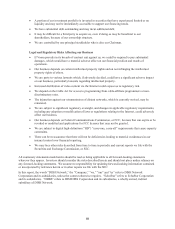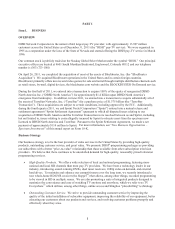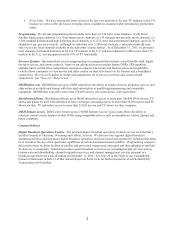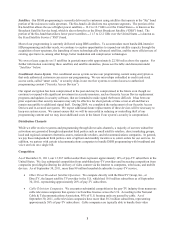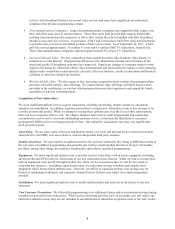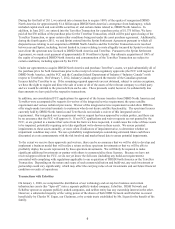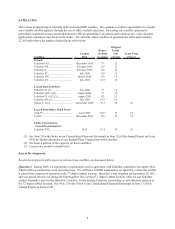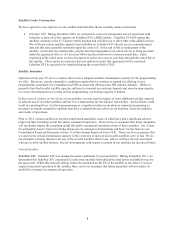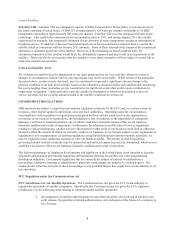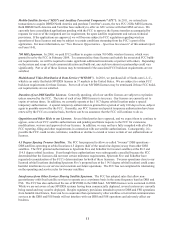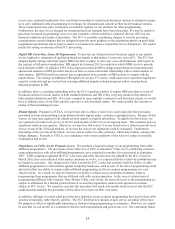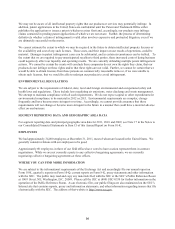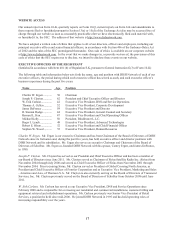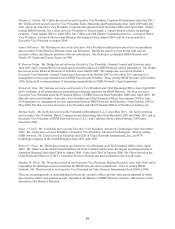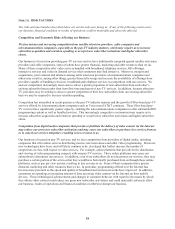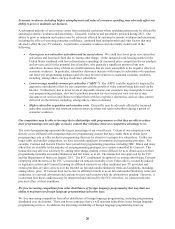Dish Network 2011 Annual Report Download - page 20
Download and view the complete annual report
Please find page 20 of the 2011 Dish Network annual report below. You can navigate through the pages in the report by either clicking on the pages listed below, or by using the keyword search tool below to find specific information within the annual report.10
10
x approval for the relocation of satellites to different orbital locations or the replacement of an
existing satellite with a new satellite;
x ensuring compliance with the terms and conditions of such assignments, licenses, authorizations
and approvals; including required timetables for construction and operation of satellites;
x avoiding interference with other radio frequency emitters; and
x ensuring compliance with other applicable provisions of the Communications Act and FCC rules
and regulations.
To obtain FCC satellite licenses and authorizations, satellite operators must satisfy strict legal, technical and
financial qualification requirements. Once issued, these licenses and authorizations are subject to a number of
conditions including, among other things, satisfaction of ongoing due diligence obligations, construction milestones,
and various reporting requirements. Necessary federal approval of these applications may not be granted, may not
be granted in a timely manner, or may be granted subject to conditions which may be cumbersome.
Overview of our Satellites, Authorizations and Contractual Rights for Satellite Capacity. Our satellites are located
in orbital positions, or slots, that are designated by their western longitude. An orbital position describes both a
physical location and an assignment of spectrum in the applicable frequency band. Each DBS orbital position has
500 MHz of available Ku-band spectrum that is divided into 32 frequency channels. Through digital compression
technology, we can currently transmit between nine and 13 standard definition digital video channels per DBS
frequency channel. Several of our satellites also include spot-beam technology that enables us to increase the
number of markets where we provide local channels, but reduces the number of video channels that could otherwise
be offered across the entire United States.
The FCC has licensed us to operate a total of 82 DBS frequency channels at the following orbital locations:
x 21 DBS frequency channels at the 119 degree orbital location, capable of providing service to
CONUS;
x 29 DBS frequency channels at the 110 degree orbital location, capable of providing service to
CONUS; and
x 32 DBS frequency channels at the 148 degree orbital location, capable of providing service to the
Western United States.
We currently do not have any satellites positioned at the 148 degree orbital location as a result of the retirement of
EchoStar V. While we have requested approval from the FCC for the future use of this orbital location, there can be
no assurance that the FCC will determine that our proposed future use of this orbital location complies fully with all
licensing requirements. If we do not use this orbital location, we could lose the associated FCC license.
In addition, we currently lease or have entered into agreements to lease capacity on satellites using the following
spectrum at the following orbital locations:
x 500 MHz of Ku-band FSS spectrum that is divided into 32 frequency channels at the 118.7 degree
orbital location, which is a Canadian FSS slot that is capable of providing service to the
continental United States, Alaska and Hawaii;
x 32 DBS frequency channels at the 129 degree orbital location, which is a Canadian DBS slot that
is capable of providing service to most of the United States;
x 32 DBS frequency channels at the 61.5 degree orbital location, capable of providing service to
most of the United States;
x 24 DBS frequency channels at the 77 degree orbital location, which is a Mexican DBS slot that is
capable of providing service to most of the United States and Mexico; and
x 32 DBS frequency channels at the 72.7 degree orbital location, which is a Canadian DBS slot that
is capable of providing service to the United States.
We also have month-to-month FSS capacity available from EchoStar on a satellite located at the 121 degree orbital
location.


